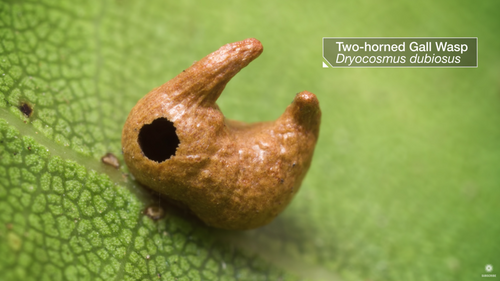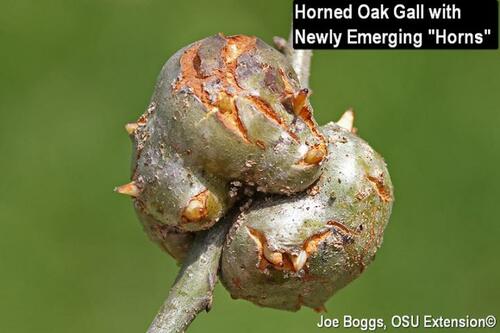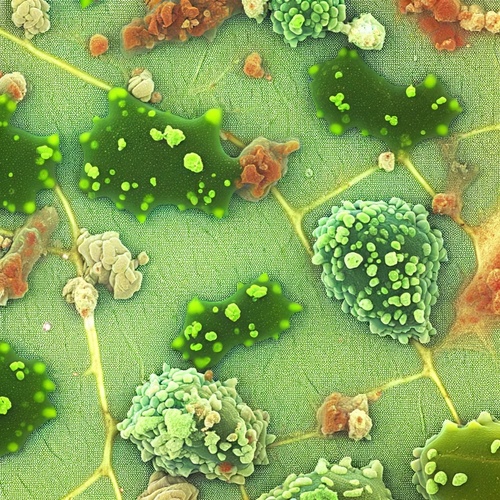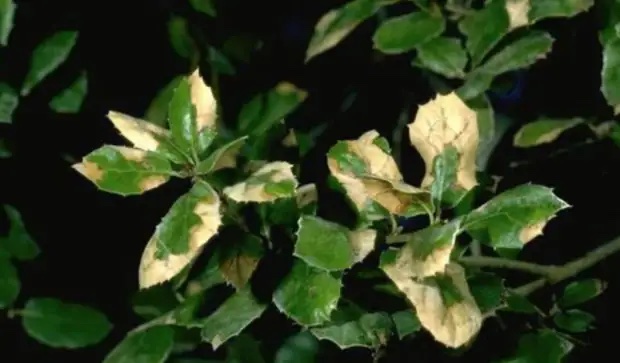Two-Horned Oak Gall Wasp: Coast Live Oaks
Introduction
Coast live oak trees have taken their share of punishment this year due to the breeding cycle of the Two-Horned Oak Gall Wasp . Known to science as Dryocosmus dubiosus , this invasive pest, common to Sonoma County, leaves a very distinctive mark on live oaks. Here, we will discuss the extent of the damage, how to recognize its telltale signs, what this means for local tree healthcare, and what can be done about it.
Two-Horned Oak Gall Wasp: Behavior and Telltale Signs

Photo Credit: https://thekidshouldseethis.com/post/deep-look-the-crazy-cribs-of-parasitic-wasps
Early signs of the Two-Horned Oak Gall Wasp include unseasonal browning or yellowing of leaves, a loss of healthy green coloration, and leaves dropping off of affected live oaks.
The Gall Wasp lays its eggs in the veins of leaves. In response, the tree develops a “gall”. This gall is a round-shaped growth on the underside of its leaves. These particular galls present with two small protrusions which have the appearance of horns, hence the insect’s name.
This condition will have its beginning in the prior year, starting in the late winter and early spring. Based on this known behavior, the reigning theory for this year’s infestation is the large amount of rain last winter, which was followed by a wet, warm spring season. This created ideal conditions for this type of wasp, providing the moisture it needs to thrive and making trees more vulnerable to their egg-laying behavior.
There are a number of wasp species that can infest oak trees, but the Two-Horned Oak Gall Wasp is one of the most common and most easily identifiable. Part of the reason it can be identified reliably is its unusual life cycle leaves a distinct pattern of evidence.
Spotting The Two-Horned Oak Gall Wasp Eggs

Photo Credit Joe Boggs
The Two-Horned Oak Gall Wasp will usually produce two generations each year. The first lay their eggs in oak flowers causing smaller galls to form. The second generation will leave its eggs in the lateral and midrib veins of oak leaves, as discussed above.
The galls will always appear on or near the lateral and midrib veins on the underside of oak leaves. They appear more often on the midrib vein, because the wasp prefers it, but can and will appear on the lateral veins as well. These galls are about the size of a steel BB or smaller and will come in variations of green and brown matching the color of the leaf itself. They also have the distinctive pair of “horns” described above.
These formations are like a blister. They are an attempt by the tree to isolate the infestation. Unfortunately, they also serve as a tidy incubation chamber for the developing wasp larvae.
Unless you are watching the leaves closely, the first signs you are likely to see include an unusual browning pattern during the last month or two of the winter or spring season, just about the time when oak trees should start coming back to life.

Microscopic view of various leaf galls on an oak leaf
The Dryocosmus dubiosus wasp itself is tiny, about the size of a gnat, and honey-brown colored. For this reason, spotting it before it lays its eggs can be tough. Your best bet is prevention, knowing the telltale signs, and doing your best to provide good preventative medicine for your live oaks.
How the Two-Horned Oak Gall Wasp Affects Trees
When the galls of the two-horned wasp form, they restrict or cut off the flow of nutrients from the branch to the outer edges of the leaf. This causes the edges of the affected leaves to turn brown after a week or two of infestation, causing a mottled brown appearance to develop. This damage is rarely deadly for the tree, but it can reduce its productivity and it will hinder the vibrant green canopy formation we love and expect from live oak trees.
So, while it is unlikely that your trees will die as a result of infestation , the presence of the wasp is a stressor. In combination with other stressors, trees may die. But the worst likely threat of this invasive insect species is regular annual infestations, leaving the beauty of live oaks consistently diminished.
Combating the Two Horned Oak Gall Wasp
Unfortunately, there is no known method of prevention for Two-Horned Oak Gall Wasp infestations. There are a number of other insect species that can and do help keep gall wasps in check. The most effective of these is yet another species of gall wasp which lays its eggs in the galls of the Two-Horned Oak Gall Wasp. This second species of wasp does not lay eggs in the leaves of oak trees, but only in the galls of the Two-Horned Oak Gall Wasp.
This leads us to a competing theory on this year’s unusually pronounced outbreak, that being that the parasitic gall wasp suffered in the previous year. If that is the case, it would certainly contribute to the problem.

Close-up of variegated oak leaves with patches of yellow and green, possibly indicating leaf damage or disease. Photo by Jack Kelly Clark
Sadly, gall wasp infestations are not well-researched at the time of this writing. The available preventative measures may include introducing insect species that keep the two-horned gall wasp in check, including the parasitic gall wasp .
However, the best way to prevent serious infestations is observation and keeping live oak trees as healthy as possible. The healthier trees are, the more able they will be to survive and possibly even resist infestation. With observation, we can collect data on this invasive pest species and develop more effective strategies to combat them in upcoming years.
Anyone with live oaks on their property should walk around each tree at least once each season, scanning for changes in leaf appearance, health, branch dieback, oozing sores, black markings as well as any other signs of stress.
If you can learn to spot these types of changes you can identify the cause and act accordingly. Sadly, we are not likely to see the end of these invasive wasps any time soon. This means that your best line of defense starts with good tree healthcare . Working with tree healthcare like Arborist Now may be key to securing the future of our trees. As stewards of the land, we must educate ourselves on these threats and take action as needed.


